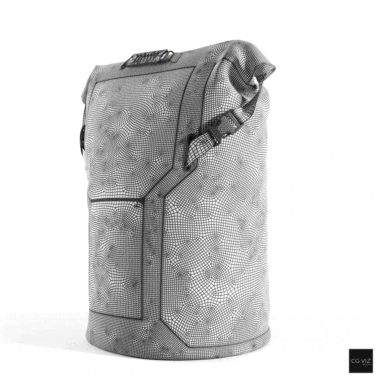The article “3D Product Visuals: Unlock in the Power of 3D Imagery’ delves into the transformative role of 3D product visualization in the marketing landscape. It explores how this technology enhances consumer engagement, streamlines the design-to-market process, and provides strategic advantages in competitive markets. The piece also examines technological innovations in 3D rendering and animation, best practices for integrating 3D visualization into marketing strategies, and presents case studies demonstrating the significant impact of 3D visualization on businesses.
Key Takeaways
- 3D product visualization significantly boosts consumer engagement by providing photorealistic imagery that enhances the online shopping experience.
- The adoption of 3D imagery in marketing strategies offers businesses a competitive edge through unique, high-quality visual content that can influence consumer perception and brand loyalty.
- Technological advancements in rendering software, hardware, and the integration of AI are streamlining workflows and setting the stage for future trends like the convergence of VR and 3D visualization.
- Effective integration of 3D visualization into marketing requires collaborative approaches, careful budgeting to maximize ROI, and consideration of legal and ethical issues surrounding product representation.
- Case studies from various businesses, including CG Viz Studio, illustrate the transformative impact and ROI of utilizing 3D visualization services in marketing efforts.
The Evolution of Marketing Through 3D Product Visualization

1. Enhancing Consumer Engagement with Photorealistic Imagery
In our quest to revolutionize marketing, we at CG VIZ Studio harness the transformative power of 3D visualization to create photorealistic imagery that captivates and engages consumers. High-end 3D visualization services revolutionize product design and marketing by offering dynamic, immersive experiences, enhancing collaboration, reducing prototyping time/cost, and creating personalized customer experiences. These services are not just about aesthetics; they are a strategic tool that can significantly impact the consumer’s journey from awareness to purchase.
By integrating 3D imagery into marketing strategies, businesses can present their products in a more interactive and appealing manner. Here are some of the key benefits:
- Dynamic presentation: Products can be showcased in various settings and lighting conditions, providing a comprehensive view.
- Customization: Potential buyers can visualize products in different colors and features, enhancing the decision-making process.
- Emotional connection: Lifelike images create a stronger emotional response, driving consumer desire.
Our commitment to excellence in 3D visualization ensures that every project we undertake is not just a visual treat but a strategic asset that drives marketing success.
We invite you to explore the possibilities with us. Discover how our expertise in 3D product visualization can elevate your brand and resonate with your audience. For more information or to discuss your project, please reach out to our team.
2. Streamlining the Design-to-Market Process
In our quest to revolutionize customer engagement with 3D product visualization, we’ve identified a pivotal advantage: the ability to streamline the design-to-market process. By embracing 3D imagery, businesses can significantly reduce the time it takes to bring a product from concept to consumer. This not only accelerates the feedback loop but also allows for rapid iteration and refinement of designs based on real-time market data.
The integration of 3D visualization into the product development cycle enhances collaboration between designers, marketers, and stakeholders. With tools like virtual prototyping, decision-makers can evaluate and modify product designs without the need for physical samples, leading to a more efficient and cost-effective workflow.
Our approach ensures that every product hits the market with its best foot forward, resonating with consumers and standing out in a crowded marketplace.
To illustrate the impact of 3D visualization on the design-to-market process, consider the following steps:
- Conceptualization and 3D modeling of the product idea
- Rapid prototyping and virtual testing for immediate feedback
- High-fidelity rendering for marketing materials and pre-sales
- Iterative refinement based on consumer and market response
- Final market launch with a fully realized and tested product
By leveraging these steps, businesses can provide customers with a more immersive and interactive shopping experience, allowing for a better understanding and appreciation of the product before purchase.
3. Case Studies: Success Stories in 3D Visualization
At the forefront of the 3D visualization revolution, we’ve witnessed a myriad of success stories that underscore the transformative power of this technology in marketing. Clients have experienced a tangible uplift in engagement and sales, thanks to the immersive and photorealistic representations of their products. For instance, Matterport’s virtual reality capabilities have not only enhanced architectural presentations but also streamlined client approvals by bridging the gap between expectation and reality.
Our collaboration with CG Viz Studio exemplifies the strategic integration of 3D imagery into marketing campaigns. Their expertise in creating high-quality, photorealistic renderings has been instrumental for businesses across various industries. Here’s a snapshot of the impact:
- Architectural firms have reduced project approval times.
- Furniture retailers have seen an increase in sales through captivating visual content.
- Consumer goods companies have differentiated themselves with personalized product experiences.
By leveraging 3D visualization services, companies are not just innovating; they are revolutionizing the way they connect with their audiences.
We invite you to explore our portfolio of case studies that demonstrate the efficacy of 3D visualization in marketing. Discover how businesses like yours have harnessed the power of 3D imagery to drive growth and establish a competitive edge in the market. For a deeper dive into these success stories, visit our website and learn how we can help you unlock the full potential of 3D product visualization.
Strategic Advantages of 3D Imagery in Competitive Markets
1. Differentiation Through High-Quality Visual Content
In the fiercely competitive landscape of modern marketing, high-quality visual content is not just a luxury; it’s a necessity for differentiation. At the heart of this transformation is the power of 3D product visualization, which allows brands to showcase their products with unparalleled clarity and detail. By leveraging advanced rendering techniques, companies can create photorealistic imagery that captivates consumers and sets them apart from the competition.
The strategic use of 3D imagery in marketing campaigns can significantly enhance the perceived value of products, influencing consumer decisions and fostering brand loyalty.
Understanding the impact of 3D visualization on consumer engagement, we have seen a surge in the adoption of these services across various industries. Retailers, for instance, utilize platforms like Furniture Visual to create compelling content without overextending their budgets. With options such as Silo Images, 360 product views, and Augmented Reality, the potential for immersive customer experiences is vast.
Here’s a glimpse at the services offered by CG Viz Studio, a leader in the field:
- 3D Rendering & Animation
- 3D Automotive Visualization
- 3D Architecture Visualization
- 3D Product Visualization
These services not only enhance the visual appeal but also provide a practical tool for A/B testing and market response analysis. By evaluating different imagery, businesses can determine what drives conversions and adapt their strategies accordingly. If you’re looking to revolutionize your marketing with 3D visualization, contact us to explore the possibilities.
2. Impact on Consumer Perception and Brand Loyalty
In our quest to revolutionize marketing, we’ve observed a profound impact of 3D imagery on consumer perception and brand loyalty. Photorealistic renderings and animations not only captivate customers but also foster a deeper connection with the brand. This immersive experience leads to a significant enhancement in brand recall and loyalty, as customers are more likely to remember and return to a brand that offers a visually engaging and interactive experience.
3D product visualization services have become a cornerstone for brands aiming to differentiate themselves in a crowded marketplace. By employing these services, brands can showcase their products in a more dynamic and appealing way, leading to increased consumer trust and a stronger brand image.
- Enhanced consumer trust through detailed and accurate product representations
- Increased engagement by providing an interactive and immersive experience
- Stronger brand image by utilizing cutting-edge visual content
By integrating 3D visualization into their marketing strategies, businesses are not only elevating the consumer experience but also setting a new standard for brand interaction.
As we continue to explore the strategic advantages of 3D imagery, it’s clear that the ability to present products in a lifelike manner is more than just an aesthetic choice—it’s a strategic business decision that can lead to long-term success. We encourage businesses to embrace this innovative approach to foster brand loyalty and gain a competitive edge.
3. Analyzing Market Response to 3D Visual Marketing Campaigns
In our quest to revolutionize marketing with product visualization services, we have meticulously analyzed market responses to 3D visual marketing campaigns. The insights gleaned from this analysis are telling; consumers are increasingly drawn to the immersive experience that 3D imagery provides. This engagement is not just superficial; it translates into measurable metrics that reflect the strategic advantages of incorporating high-quality visual content into marketing efforts.
Consumer feedback and client testimonials consistently highlight the effectiveness of 3D visualization in capturing attention and conveying product details that static images simply cannot match. For instance, CG Viz Studio’s clients have reported significant upticks in consumer interest and sales conversions following the deployment of 3D marketing assets.
By integrating 3D visualization into their marketing strategies, businesses are not only differentiating themselves from competitors but are also fostering stronger brand loyalty among their customer base.
To illustrate the impact of 3D visualization, consider the following data points from recent campaigns:
- Increased consumer engagement by up to 70%
- Improvement in sales conversion rates by over 40%
- Enhanced brand recall and recognition
These figures underscore the transformative potential of 3D imagery in marketing. As we continue to push the boundaries of product visualization, we invite businesses to explore the myriad benefits that 3D marketing can offer. Embrace the future of marketing with us, and let’s create captivating visual experiences that resonate with your audience.
Technological Innovations in 3D Rendering and Animation

1. Advancements in Rendering Software and Hardware
As we delve into the realm of 3D product visualization, it’s imperative to acknowledge the significant strides in rendering software and hardware. The year 2024 heralds a suite of revolutionary features in rendering technology, including AI-acceleration, advanced ray tracing, and cloud rendering services. These enhancements not only bolster the efficiency of rendering processes but also elevate the quality of the final imagery to unprecedented levels.
The introduction of the SSD-1B model by Segmind marks a pivotal moment in text-to-image generation, showcasing remarkable improvements in size, speed, and quality. This leap forward is a testament to the relentless pursuit of innovation in the field of creative AI. Similarly, applications like deep-image.ai are setting new benchmarks in advanced image processing, catering to a wide array of image enhancement needs.
The synergy between cutting-edge software and robust hardware solutions is reshaping the landscape of 3D visualization, enabling creators to push the boundaries of photorealism and interactivity.
To illustrate the impact of these advancements, consider the following table which encapsulates the comparative performance metrics of leading rendering software:
| Software | AI-Acceleration | Ray Tracing | Cloud Services |
|---|---|---|---|
| SSD-1B | Yes | Advanced | Available |
| DALL·E | Yes | Standard | Limited |
| Midjourney | No | Standard | Not Available |
| Stable Diffusion | Yes | Advanced | Available |
In our collective journey towards harnessing the full potential of 3D imagery, we must remain vigilant of the evolving technological landscape. Embracing these advancements not only empowers us to deliver captivating visual content but also solidifies our position as frontrunners in the competitive market of product visualization.
2. The Role of Artificial Intelligence in Streamlining Workflows
At the heart of modern marketing, artificial intelligence (AI) is a pivotal force in enhancing the efficiency and precision of 3D visualization workflows. By automating repetitive tasks and analyzing complex data, AI enables us to focus on the creative aspects of product visualization, ensuring that every detail is meticulously crafted to meet the highest standards of photorealism. AI’s integration into 3D imagery workflows is not just an innovation; it’s a revolution in the making.
AI-driven tools are now indispensable in the realm of 3D product visualization, offering transformative benefits such as accelerated rendering times and improved collaboration between teams. These tools facilitate a seamless design-to-market journey, allowing for rapid prototyping and iterative design processes. The automotive industry, in particular, has witnessed the transformative effects of AI-enhanced 3D visualization, with success stories highlighting significant reductions in time-to-market for new vehicle designs.
Embracing AI in our workflows means unlocking new levels of productivity and innovation. It empowers us to deliver captivating visual content that resonates with consumers and stands out in the competitive marketplace.
To illustrate the impact of AI on 3D visualization, consider the following points:
- Innovative animation techniques, including 3D and hybrid animations, revolutionize product marketing.
- AI enhances 3D visualization, streamlining design processes and enabling precision and collaboration.
- Success stories in the automotive industry showcase transformative effects.
In conclusion, the strategic implementation of AI in 3D visualization workflows is essential for businesses aiming to maintain a competitive edge. It not only refines the quality of visual content but also fosters a culture of innovation and efficiency.
3. Future Trends: The Convergence of VR and 3D Visualization
As we peer into the horizon of technological advancements, we recognize the transformative potential of the convergence between virtual reality (VR) and 3D visualization. This synergy is not merely a trend but a paradigm shift that is reshaping the landscape of marketing and product presentation. The immersive experiences offered by VR, when combined with the detail and precision of 3D visualization, create a compelling narrative for products and spaces.
Virtual reality and 3D visualization are no longer confined to the gaming and entertainment industries. They are now pivotal in marketing strategies, offering an unparalleled level of interaction and engagement. Here are some key benefits of this convergence:
- Enhanced customer experience with interactive product demos
- Real-time modifications and customizations in a virtual space
- Improved understanding of spatial relationships and product functionality
By integrating VR with 3D visualization, businesses can offer customers a ‘try before you buy’ experience, significantly reducing the uncertainty that often accompanies online purchases.
Our commitment to staying at the forefront of these technologies is evident in our high-end 3D visualization services. We offer comprehensive solutions that cater to various needs, from architectural renderings to product animations. Our services are designed to meet the evolving demands of industries, ensuring that our clients remain competitive and relevant in a rapidly changing market.
Best Practices for Integrating 3D Visualization into Marketing Strategies
1. Collaborative Approaches Between Marketers and 3D Artists
In our pursuit of marketing excellence, we recognize the transformative power of collaboration between marketers and 3D artists. The synergy of marketing acumen and artistic expertise is pivotal in crafting visuals that resonate with audiences and drive engagement. By uniting the strategic insights of marketers with the creative vision of 3D artists, we unlock a new dimension of product visualization that is both engaging and effective.
- Establish clear communication channels for ongoing dialogue and feedback.
- Define shared goals and objectives to align efforts.
- Leverage each other’s strengths to enhance the final product.
Embracing a collaborative approach not only streamlines the creative process but also ensures that the end result aligns with the marketing strategy and brand identity.
To maximize the impact of 3D visualization, it is essential to integrate these collaborative practices into the marketing workflow. This integration fosters a culture of innovation and continuous improvement, where each project benefits from the collective expertise of both marketers and 3D artists. If you’re looking to elevate your marketing strategy with high-quality 3D imagery, we invite you to explore the possibilities and reach out for a partnership that will set your brand apart.
2. Budgeting for 3D Visualization: Maximizing ROI
In the realm of marketing, the integration of 3D visualization is a strategic investment that can significantly enhance product appeal and consumer engagement. Allocating funds towards 3D imagery must be done judiciously to ensure a high return on investment (ROI). At our core, we understand the balance between cost and impact; thus, we advocate for a budgeting approach that prioritizes value over mere expenditure.
Cost-effectiveness is a critical factor when considering 3D visualization services. For instance, platforms like Furniture Visual offer comprehensive packages that include Silo Images, Vignette images, 360 product views, Product Videos, and Augmented Reality, all for an accessible price point. This democratization of high-quality visual content allows businesses of all sizes to compete effectively in the market.
By leveraging advanced 3D technology, companies can create immersive and interactive experiences that resonate with consumers, driving both sales and brand loyalty.
To maximize ROI, it is essential to understand the various pricing models and service offerings available. Here is a simplified breakdown of common services and their potential costs:
- 3D Product Rendering: Starting from $100 per image
- Architectural Visualization: Typically ranges from $300 to $500 per view
- Animation Services: Can vary widely, starting at $1,000 for basic animations
These figures are indicative and can fluctuate based on project complexity, turnaround time, and specific client requirements. It is advisable to consult with service providers for detailed quotations tailored to your project’s needs. Remember, investing in 3D visualization is not just about the immediate impact but also about setting the stage for long-term brand evolution and market presence.
3. Legal and Ethical Considerations in Product Visualization
As we harness the power of 3D visualization to revolutionize marketing strategies, it’s imperative to navigate the legal and ethical landscapes with due diligence. Ensuring compliance with copyright and intellectual property laws is not just a matter of legality; it’s a cornerstone of ethical business practices. When creating photorealistic 3D renderings, it’s crucial to respect the original designs and trademarks of products.
In the realm of product visualization, transparency with consumers is also paramount. Misrepresentation of products through 3D imagery can lead to consumer distrust and legal repercussions.
To maintain integrity and trust, marketers and 3D artists must collaborate to establish clear guidelines that honor both creative freedom and legal boundaries. Here’s a concise list of considerations:
- Verify the ownership of intellectual property before visualization.
- Obtain necessary licenses or permissions for product depiction.
- Accurately represent product features and specifications.
- Disclose the use of 3D imagery in marketing materials when appropriate.
By adhering to these principles, businesses can leverage the benefits of high-end 3D visualization services for marketing and e-commerce, such as increased customer engagement, higher sales conversions, and reduced return rates, while fostering a culture of respect and responsibility.
Case Studies: Transformative Impact of 3D Visualization on Businesses
1. Small Enterprises Leveraging 3D Imagery for Growth
In our journey to explore the transformative power of 3D visualization, we’ve observed its remarkable impact on small enterprises. These nimble businesses are harnessing the potential of 3D imagery to not only compete but also to thrive in today’s market. By offering an immersive experience, 3D visualization revolutionizes design and development with enhanced communication, rapid prototyping, and marketing assets. Case studies showcase its impact across industries, emphasizing efficiency and innovation.
One might assume that the cost of such advanced technology would be prohibitive for smaller players. However, innovative solutions tailored to specific needs have emerged, making high-quality visual content both accessible and affordable. For instance, platforms like Furniture Visual provide comprehensive packages, including Silo Images, Vignette images, and Augmented Reality, for as little as $130 per product.
Our collective experience with industry partners like CG Viz Studio underscores the strategic value of 3D visualization. Their expertise in creating photorealistic renderings and animations has enabled numerous small businesses to vividly showcase their products, resulting in increased sales and brand presence.
To fully leverage the benefits of 3D visualization, small enterprises should consider the following steps:
- Identify the unique selling proposition of their products and how 3D imagery can enhance it.
- Partner with a reputable 3D visualization service that understands their market niche.
- Integrate 3D assets into their marketing campaigns to create a cohesive and engaging brand narrative.
2. Success Metrics: Analyzing the ROI of 3D Marketing Efforts
In our quest to revolutionize marketing strategies, we’ve embraced the transformative power of 3D renderings. These visual assets are not just about aesthetic enhancement; they are a strategic investment. The return on investment (ROI) from 3D marketing efforts can be quantified through various success metrics, such as increased engagement, higher conversion rates, and enhanced brand perception.
Enhancing marketing strategies with 3D renderings has proven to revolutionize design decision-making, collaboration, and customer engagement. The interactive experiences and personalization afforded by 3D visualization create a unique client synergy, pivotal for success in competitive markets.
By meticulously analyzing market response and sales data, businesses can gauge the effectiveness of their 3D visual content. A positive shift in these metrics often correlates with the strategic use of high-quality 3D imagery.
To illustrate, consider the following table showcasing a hypothetical scenario of ROI analysis:
| Year | Investment in 3D Visualization | Revenue Increase | ROI |
|---|---|---|---|
| 2021 | $20,000 | $100,000 | 5x |
| 2022 | $25,000 | $150,000 | 6x |
| 2023 | $30,000 | $200,000 | 6.67x |
This table exemplifies how strategic investments in 3D imagery can lead to substantial revenue growth and a significant return on investment. It’s essential for businesses to track these metrics to validate the efficacy of their marketing strategies.
3. Long-Term Brand Evolution with Consistent Use of 3D Assets
In our journey to foster enduring brand growth, we’ve witnessed the transformative power of 3D visualization. Consistent use of 3D assets not only solidifies brand identity but also propels it into the future, adapting seamlessly to evolving market trends and consumer expectations. By integrating 3D imagery into our marketing strategies, we ensure a dynamic and immersive brand experience that resonates with our audience over time.
- Brand Recognition: Enhanced through consistent visual storytelling.
- Customer Engagement: Deepened by interactive 3D experiences.
- Innovation: Showcased by adopting the latest 3D technologies.
- Market Adaptability: Achieved by updating 3D assets to reflect current trends.
As we continue to leverage 3D visualization, we are not just keeping pace with the industry; we are setting the benchmark for excellence in digital marketing. Our commitment to this approach has reaped measurable benefits in customer loyalty and market share.
The strategic deployment of 3D assets is a testament to our dedication to quality and innovation. We invite you to explore the impact of 3D modeling on creative campaigns and discover how it can revolutionize your brand’s trajectory.
Get your project estimated within 60 minutes - simply send us your project brief!
Conclusion
In summary, the advent of 3D imagery and product visualization services has ushered in a transformative era for marketing strategies across various industries. The academic discourse surrounding this technological revolution highlights the significant impact on consumer engagement, decision-making processes, and ultimately, the commercial success of products. Companies like CG Viz Studio exemplify the prowess of 3D visualization in enhancing product appeal, offering clients a competitive edge through high-quality, photorealistic renderings and animations. As evidenced by the plethora of positive testimonials, the value of such services is clear, with clients lauding the seamless communication, swift turnarounds, and exceptional outcomes. The integration of 3D visualization into marketing practices is not merely a trend but a paradigm shift, redefining the standards of presentation and interaction in the digital marketplace. As we look to the future, it is imperative for businesses to embrace these innovative tools to captivate and satisfy the evolving demands of a visually driven consumer base.
Frequently Asked Questions
3D product visualization involves creating digital models of products that can be rendered into photorealistic images or animations. This technique benefits marketing strategies by enhancing online and offline presentations, providing consumers with an immersive experience, and allowing for easy customization and adjustments to showcase products in different scenarios without the need for physical prototypes.
3D imagery allows brands to showcase their products with high-quality visual content that stands out in a crowded marketplace. It can improve consumer perception and foster brand loyalty by presenting products in a more engaging and interactive way. Additionally, it can highlight product features and quality more effectively than traditional photography.
Technological advancements such as improved rendering software, faster hardware, and the integration of artificial intelligence are streamlining 3D visualization workflows. The convergence of virtual reality (VR) and 3D visualization is also a significant trend, offering even more immersive experiences for consumers and new possibilities for marketers.
Best practices include collaborating closely with skilled 3D artists, setting clear objectives for the visualization, budgeting effectively to maximize return on investment, and considering legal and ethical implications when creating and using 3D visual content. It’s also important to stay informed about the latest trends and technologies in 3D visualization.
Yes, small enterprises can significantly benefit from 3D visualization by leveling the playing field with larger competitors. It allows them to showcase their products with the same level of quality and professionalism, potentially increasing their market presence and sales. Additionally, 3D assets can be used across various marketing platforms, enhancing their overall marketing efforts.
Companies measure the success of their 3D marketing efforts through various metrics such as increased engagement rates, higher conversion rates, improved customer feedback, and a rise in sales figures. They may also analyze market response through social media interactions and the performance of 3D visualization in advertising campaigns.



